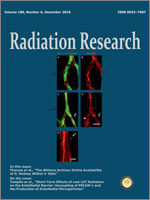Until the end of the 20th century, mouse germ cell data on induced mutation rates, which were collected using classical genetic methods at preselected specific loci, provided the principal basis for estimates of genetic risks from radiation in humans. The work reported on here is an extension of earlier efforts in this area using molecular methods. It focuses on validating the use of array comparative genomic hybridization (array CGH) methods for identifying radiation-induced copy number variants (CNVs) and specifically for DNA deletions. The emphasis on deletions stems from the view that it constitutes the predominant type of radiation-induced genetic damage, which is relevant for estimating genetic risks in humans. In the current study, deletion mutations were screened in the genomes of F1 mice born to unirradiated or 4 Gy irradiated sires at the spermatogonia stage (100 offspring each). The array CGH analysis was performed using a “2M array” with over 2 million probes with a mean interprobe distance of approximately 1 kb. The results provide evidence of five molecularly-confirmed paternally-derived deletions in the irradiated group (5/100) and one in the controls (1/100). These data support a calculation, which estimates that the mutation rate is 1 × 10–2/Gy per genome for induced deletions; this is much lower than would be expected if one assumes that the specific locus rate of 1 × 10–5/locus per Gy (at 34 loci) is applicable to other genes in the genome. The low observed rate of induced deletions suggests that the effective number of genes/genomic regions at which recoverable deletions could be induced would be only approximately 1,000. This estimate is far lower than expected from the size of the mouse genome (>20,000 genes). Such a discrepancy between observation and expectation can occur if the genome contains numerous genes that are far less sensitive to radiation-induced deletions, if many deletion-bearing offspring are not viable or if the current method is substandard for detecting small deletions.
How to translate text using browser tools
21 November 2016
Genome-Wide Deletion Screening with the Array CGH Method in Mouse Offspring Derived from Irradiated Spermatogonia Indicates that Mutagenic Responses are Highly Variable among Genes
Jun-ichi Asakawa,
Mieko Kodaira,
Akiko Miura,
Takahiro Tsuji,
Yoshiko Nakamoto,
Masaaki Imanaka,
Jun Kitamura,
Harry Cullings,
Mayumi Nishimura,
Yoshiya Shimada,
Nori Nakamura





